
As an entrepreneur, I’ve met many people over the years, from investors to journalists, from customers to suppliers and from engineers to janitors. I always prided myself on calling them by their first name and tried my best to show them how important they are. Like William James, the father of American psychology, said: “The deepest principle in human nature is the craving to be appreciated.”
However, I was facing a big problem: Over the years, my memory began to fade. When meeting with somebody I had only met a few months prior, I found it challenging to remember details about them. Therefore, my rapport with them was not as warm as I wished, and I felt like I didn’t get the full potential of the discussion.
I remember precisely when I decided to take action against my faulty memory. It was in 2016 during a meet-and-greet in San Francisco. I was chatting with John for an hour when he suddenly whispered into my ear, “No offense taken, but my name is Paul.” I was ashamed of myself, and I’m almost certain this mistake cost me a big business opportunity, as John — sorry, Paul — was the perfect prospect for my business.
Enter Moleskine
I read that, over the course of his life, David Rockefeller (former Chase CEO) wrote about 200,000 notecards to document his interactions with world leaders. So, I decided to buy a Moleskine notebook dedicated to taking notes on people. I started to populate the pages with everything that came to my mind. One page per person. I would write contact details, names of their loved ones, jobs, hobbies, food preferences and even bullet points on what we discussed when we last met.
However, I was quickly confronted with the limitations of a paper notebook. The notes started to pile up, and I was running out of space on each page. For instance, the person I documented on the first page of the Moleskine was full, so I had to start another page near the end. I needed to write “see additional notes at the end of the notebook” — not ideal. The second problem was that I was not always carrying my “people’s notebook,” so I wasn’t always able to review my notes prior to meeting someone, especially when the encounter was random.
So Long, Notebook; Welcome, Technology
Naturally, my smartphone and computer have replaced my Moleskine. I was able to transfer and organize all my notes and easily retrieve them anytime, anywhere on my pocket device. It is essentially an extension of my brain now. It’s easy to pull up and skim through previous interactions just before meeting someone; it’s like magic.
What I also like a lot is the ability to keep track of the next steps. I put reminders in my calendar so that I never forget important dates and deadlines.
To me, that’s the beauty of technology. With proper usage, it supercharges our brain and allows us to focus on what’s most important: to extract the best of human interactions. Like Dale Carnegie explained, it’s not so difficult to win friends and influence people when you have the right system in place.
Documenting Your Interactions
I’ve tried a lot of tools, from spreadsheets like Google Sheets or Microsoft Excel to dedicated web apps like Monica or Folk, but so far, my preference goes to a personal relationship management workspace (PRM) like Notion or Airtable. These platforms are designed to be easy to customize, safe and secure.
Here are a few tips to help you better document your interactions with others and maintain your professional relationships:
• Take notes during or immediately after meetings. If the former, be sure to ask the individual if they mind if you jot down a few things during your discussion.
• Create a to-do list, and set reminders. This way, you don’t lose track of important dates and opportunities to reach out.
• Pay close attention to little details. Maybe it’s something like, “I’ll have to leave in 15 minutes because tonight is my son’s graduation” or “Next weekend, my husband and I will visit Yosemite.” This information can serve as the perfect ice-breaker the next time you meet.
• Before each meeting, check your notes and social media. LinkedIn and Twitter, in particular, are very valuable sources of information that can help you stay up to date with each of your professional relationships.
• Follow up. Be proactive and reach out. For example, there is nothing worse than making an intro between two people and then never receiving an update on how it went.
I also recommend skimming your PRM once a week. By doing this, you avoid missing an opportunity to reach out to someone for little things (like an anniversary) or to ask about a specific project. In the long run, you’ll be amazed by all the opportunities this simple trick brings.
When you meet someone and you are able to pick up the conversation as if you had never left each other, it proves that you are genuinely interested in the relationship. It shows seriousness and conscientiousness. And that creates a warm bond. Whether it is a business meeting or a casual chat, I guarantee your discussion will end well.
